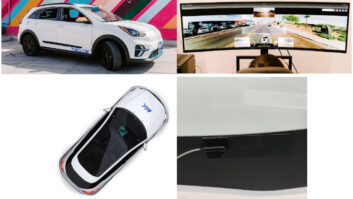PAINTED POST, N.Y. – Corning recently used an uncharacteristically early pre-International CES international press tour of its glass-development campus here to formally unveil the next generation of its popular damage-resistant Gorilla Glass cover glass for mobile devices and other applications.
Corning executives explained that they didn’t wait until CES for the formal unveiling of Gorilla Glass 4 this year at the request of several device manufacturer customers that wanted to get new products on the market prior to the end of the quarter.
With widespread reports about Apple’s difficulty obtaining sapphire glass for its iPhone 6 products from financially troubled GT Advanced, the use of a new stronger Gorilla Glass brings a significant added-value message to competitive devices.
The first devices using Gorilla Glass 4 are in production now and will be coming to market shortly, Corning executives said.
Cliff Hund, Corning East Asia president, said Gorilla Glass 4 will initially appear in smartphones, tablets and notebooks.
Corning executives said Gorilla Glass 4 represents the most significant innovation in Gorilla Glass since its inception in 2006. The new glass is said to provide not only highly durable qualities, but also has the ability to make glass thinner, lighter, more flexible, and even moldable with multiple curved edges and surfaces for use in products like wearable electronics.
In addition to using Gorilla Glass 4 for handheld and portable electronics, the company is venturing into new use areas, including the automotive industry, where the ultra-thin and highly flexible qualities of the glass can be adapted for a variety of applications. Examples consist of touchscreen displays on car instrument panels, or in windshields and sunroofs where lighter glass helps reduce overall vehicle weight and contributes to making cars more fuel efficient to meet stricter international regulatory standards.
To date, Gorilla Glass has been adopted by more than 100 different manufacturers, including many of the leading mobile electronics names. More than 3 billion devices in use in the market today contain Gorilla cover glass, with a current growth rate of more than 1 billion per year, Corning said.
Top smartphone/tablet brands using Gorilla Glass include Samsung, LG, HTC, Motorola and Microsoft.
On the tour of its glass facilities, Corning went to great lengths to illustrate how each new composition goes through research and development, process development and testing before being launched on the market.
In the development of Gorilla Glass 4, Corning said consumer focus groups repeatedly determined that screen damage resistance was one of the most desired characteristics in a new smartphone or tablet purchase today.
So Corning scientists went to work evaluating thousands of broken smartphones and conducting extensive 1-meter drop tests in formulating a new extratough version of Gorilla Glass that not only makes next-generation phones stronger, it enables making some of those phones thinner and lighter while still offering the same level of damage resistance as the previous-generation devices.
At equal thicknesses, Corning said Gorilla Glass 4 offers up to two times the damage resistance of the previous Gorilla Glass 3 introduced a year ago and greater strength than other hardened, aluminosilicate glasses on the market.
The new composition was specifically designed to first resist surface scratching, which creates a weak point in the glass from which cracks emerge, and then adds additional compressive strength and flexibility to resist multi-point pressure and vibration that acts on stress points to crack screens.
In developing Gorilla Glass 4, Corning said the goal was to reduce cracked screens from drops on rough surfaces, such as concrete or asphalt, where surface scratching contributes to broken cover glass more than 70 percent of the time.
To simulate real-world conditions, Corning scientists conducted a battery of drop tests from 1 meter onto a rough (180-grit sandpaper) surface.
To combat such conditions, Corning developed a new ultra-strong glass compound that survives such drops up to 80 percent of the time, and is two times tougher than competitive glass. Corning said competitive glass made of soda-lime “breaks nearly 100 percent of the time.”
Corning Gorilla Glass is made using two proprietary processes, including a fusion process that is also used to make glass for LCD panels to produce a “perfect glass” that needs no further finishing to improve the surface. The second is to take the perfect glass from the fusion process and put it through a chemical ion-exchange process that takes small ions and replaces them with larger ions, causing a surface depression in the material from which the glass gets its compressive strength.
The resulting damage-resistant glass is said to have the ability to significantly limit strength reduction due to flaws (scratches or dings on the surface of the glass).
Jaymin Amin, Corning Gorilla Glass technology division VP, said the company’s extensive drop tests included some limited comparisons with rival sapphire materials, dropping samples 60 centimeters onto a granite surface and found breaking in all five attempts. Samples of Gorilla Glass 4 at the same thickness recorded no failures even from a drop of up to 2.2 meters.
Corning said it has developed other processes manufacturers can select to add features to Gorilla Glass 4 – like anti-microbial characteristics (using silver in the glass composition) and bonding with other materials, like stainless steel, to keep surfaces for things like major appliances resistant to scratching and fingerprints.
For the first time, Corning is not going to discontinue availability of the previous generation material (Gorilla Glass 3) as the newer formulation (Gorilla Glass 4) enters the market, said James R. Steiner, Corning specialty materials senior VP and general manager. This will give device makers more cost-value options for their product lines.
Manufacturers also have the option of going with an up to 25 percent thinner sheet of Gorilla Glass 4 to keep their products thinner and lighter, with the same strength characteristics as previous generation devices, or opt for devices with greater overall damage resistance.













